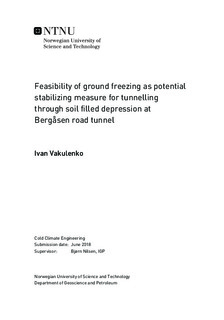| dc.description.abstract | The master thesis describes a technique of artificial ground freezing (AGF) using as a potential method of water saturated soil stabilizing during tunnel excavation in North Norway.
The research is based on real project of a tunnel planned by Statens vegvesen Norwegian public roads administration as a part of European highway E6 reconstruction in Grane kommune of Nordland region.
Based on geotechnical sounding, it was found that the 675 m long tunnel will cross a
depression over a section of approximately 20m, which is filled by a mix of water-saturated materials (silt, sand and gravel). To handle this section, artificial ground freezing method is taken into consideration.
The tunnel route is based on assumption that even crossing the deepest section ofmoraine, the tunnel bottom part will still lie on the rock basement. Therefore, the designed ice-wall covers only that part of the tunnel, which will be excavated in soil.
The paper includes an analysis of geological and hydrological conditions of moraine deposit area based on Statens Vegvesen project papers, which is followed by the determination of design parameters for an ice-wall created by AGF method in the watter saturated soil section.
The ice-wall function is to stabilize soil layer for safe excavation and permanent lining installation. Thus, it is shown, how moraine deposit parameters including seepage velocity, cohesion, Young s modulus and friction angle, affect ice-wall structure.
The stability analysis of the tunnel is carried out in Rocscience RS2 software. Therefore, the model of designed ice-wall is set-up for simulation to get the distribution of displacements on the merge of excavated tunnel and frozen ground layer. Thereafter the stability with permanent lining is analyzed. Results of the simulation show that the designed ice-wall and further permanent lining are sufficient to maintain the tunnel stability. However, due to lack of broad geological and hydrological data, more comprehensive research should be carried out. To show the hazards of incorrect geology data, a case of the tunnel completely excavated in moraine deposit is considered and modeled as well. | |

